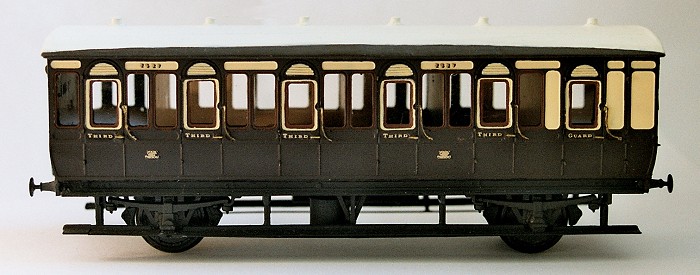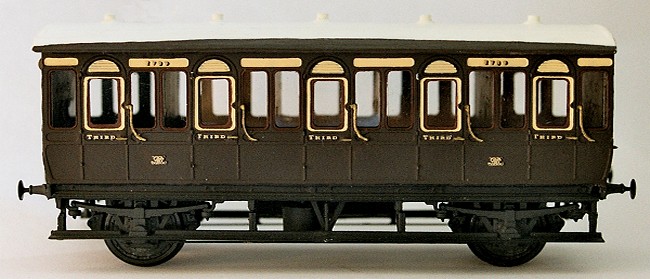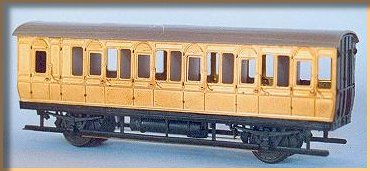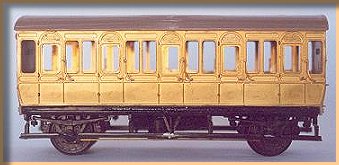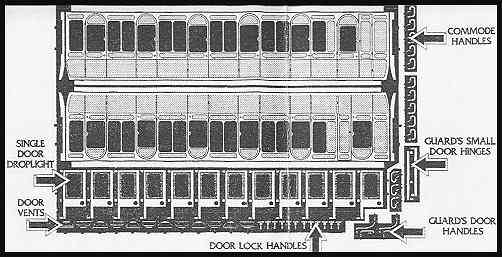| Section Page | Previous Page | Next Page |
Shirescenes Holden 4-wheelersby Mikkel Kjartan
The Shirescenes etched brass conversion sides for the Ratio 4-wheelers have considerably expanded the scope for those less experienced with GWR coach kits. Though perhaps not for the complete novice, these sides have been prepared for glue assembly and constitute a natural progression from the Ratio kits themselves. It has to be said that the kits are not entirely accurate in one or two areas, and some involve slightly tricky operations. However, they are a relatively cheap and quick way to acquire some very useful coaches that are not seen so often on GWR layouts. As can be seen from the 4mm kit lists, the Shirescenes range constitutes a number of different types. This page concentrates on the Holden "Metro" coaches, of which two types are available. However, most of the construction notes for these particular kits are generally applicable to the Shirescenes range.
The prototypes The Holden 4-wheelers were introduced for the London suburban services in 1880, and were manufactured to varying diagrams until the turn of the century. They were designed by William Holden before he moved on to the GER, and were easily recognisable by the distinctive half-circle shape of the door vents. You can read more about the specific details of these coaches in the GWR Features section. The Shirescenes sides for the Holden vehicles constitute a full 3rd diagram S17, and a Brake 3rd diagram T59. Note that some coaches of these diagrams also ran as Second Class coaches in the early years – apparantly, the only difference was in the upholstery. The "Metro" coaches ran in close-coupled sets in suburban London until the 1920s, at which point they were disbanded as sets and distributed for ordinary branchline work around the system. Like the rest of the 4-wheeled types, many ended their days as departmental stock or as workmans trains in the 1930–40s.
The S17 and T59 offer a good opportunity to add a bit of difference to a GWR layout: The most obvious potential of the kits is to use them in a suburban setting – a scene that is surprisingly rarely modelled. That said, the lack of any First class types in the Shirescenes range is a bit unfortunate, since suburban rakes of these coaches usually included such accommodation. You can choose to ignore this and make up a rake of Thirds only, or you can compromise and add the Ratio Composite. The latter is not entirely inappropriate, as some non-Holden 4-wheelers also worked the suburban services, although usually in sets of their own. Alternatively, you could add a kit from the more sophisticated Roxey Mouldings range, but note that these are etched brass kits, and thus require some kit-building experience. Another option is to go for a workmans train, composed of a short rake of S17s and T59s. During the 1930s, these trains were painted in the somewhat dingy all-over brown – a less challenging paint-job for the modeller than the more complex chocolate and cream. Well weathered and worn, and perhaps with various modified details such as the removal of stepboards, these coaches can represent a characterful picture of a rarely modelled type of train. Finally, branchline modellers can use these coaches to add variety to a rake of Ratio 4-wheelers set in the 1920s-1940s. During this period, the Holden Metro stock was mixed with ordinary 4-wheelers in several instances – including the Faringdon branch, where two Holden Brake Thirds ran with a U4 for several decades.
The kits Let it be said at once that the kits do involve two fairly significant compromises: Firstly, the Ratio ends used with the Shirescenes sides are in fact incorrect for the Holden Metro stock. The Holden coaches had six end panels, while the Ratio ends only have five. Secondly, the London suburban sets were slightly reduced in height compared to other 4-wheelers, and the kits do not represent this. The latter will really only be apparant if you run the different rakes simultaneously, but the end-panel problem will inevitably be visible to those who notice such things. I see no practical way of solving this one – but then again we OO modellers don't much like to view our rakes end-on anyway! The instructions are brief but to the point, and come with a photocopy of the etch (see below), which gives an overview of the main parts. Note, however, that the instructions do have one major shortcoming: While the T59 uses unmodified parts from the Ratio Brake 3rd, the S17 uses the Ratio S9/U4 chassis and roof, both of which require shortening by approximately 9mm. The instructions are really not very clear about this, and someone without a drawing may miss this rather significant fact entirely.
|
| Section Page | Previous Page | Next Page |
